UNIT 2 MODULE 5
PROBLEMS INVOLVING DISTANCE AND THE PYTHAGOREAN THEOREM
THE PYTHAGOREAN THEOREM
The Pythagorean Theorem states the relationship between the lengths of the three sides of a right triangle:

C2 = A2 + B2, where A and B are the lengths of the two shorter sides (the legs) and C is the length of the longer side (the hypotenuse).
The CIRCUMFERENCE of a circle
The distance around a circle is called its circumference C, and is determined by the circle's radius (r) or diameter (D):

EXAMPLE 2.5.1
Find the missing side length for each triangle shown below.

EXAMPLE 2.5.1 solutions
1. We need to find the length of the hypotenuse of a right triangle where one leg measures 8 inches and the other leg measures 5 inches. According to the Pythagorean Theorem,
82 + 52 = C2
64 + 25 = C2
89 = C2
![]()
2. We need to find the length of one leg of a right triangle where the other leg measures 16 cm and the hypotenuse measures 20 cm. According to the Pythagorean Theorem,
202 = x2 + 162
400 = x2 + 256 (We want to isolate x on one side of the equals sign.)
400 – 256 = x2
144 = x2
![]()
x = 12 inches
EXAMPLE 2.5.2
The diagram below shows the rectangular pen in which Gomer confines his wolverines and badgers. In order to prevent the wolverines from dating the badgers, Gomer is going to build a fence running from one corner of the pen to the opposite corner, thus dividing the pen into two smaller pens. Assuming that construction of such a fence will cost $1.25 per foot, find the total cost of this fence.

A. $4500 B. $500 C. $168 D. $56
EXAMPLE 2.5.2 solution
We need to find the length of the
fence (in feet) and multiply the length by the cost factor of $1.25 per foot.
We can use the Pythagorean Theorem
to find the length of the fence, since the fence is the hypotenuse of a right
triangle whose legs measure 40 yards and 20 yards respectively. Since we want
the length in feet, rather than yards, we will convert those measurements to
feet before using the Pythagorean Theorem.
(40 yards)(3 feet per yard) = 120
feet. (20
yards)(3 feet per yard) = 60 feet.
Now let L be the length of the
fence. According to the Pythagorean Theorem:
L2 = 1202 +
602
L2 = 14,400 + 3,600
L2 = 18,000
![]()
The length of the fence is roughly
134 feet, and the cost is $1.25 per foot, so the total cost is ($134)($1.25) =
$167.50
EXAMPLE 2.5.3
Study the race course shown below. If Gomer runs 62 laps around this course, how many miles will he have run?

A. 4.6 miles B.
9.2 miles C. 7.5 miles D. 4.4 miles
EXAMPLE 2.5.4
The diagram below shows the path the Plato takes when he goes for a philosophical stroll. Plato starts at home, proceeds to the toga shop, then heads north to the tunic store, then returns home. On average, Plato thinks one profound thought for every 10 yards that he walks. Find the total number of profound thoughts that he will think during this walk.

A. 60 B. 10 C. 100 D. 258 E. None of these
EXAMPLE 2.5.5
The figure below shows an aerial view of The Hurl-O-Matic, a
carnival ride in which the passengers are seated in a car, attached to the end
of an arm which rotates rapidly around a central hub. Suppose that the length of the arm is 64 feet, and that, at
full speed, it takes 10 seconds to for the car to complete one revolution. Find
the speed of the car.

A. 40 miles per hour
B. 10 miles per hour
C. 27 miles per hour
D. 21 miles per hour
E. 37 miles per hour
EXAMPLE 2.5.6
Find the distance around the racetrack shown below.

A. 0.23 miles B. 0.48 miles C. 0.0067 miles D. 0.35 miles
EXAMPLE 2.5.7
How fast (in miles per hour) does the Earth travel as it orbits the sun? (Note: the Earth's orbit is approximately circular, with a radius of 93,000,000 miles.)
EXAMPLE 2.5.8
The diagram on the left below shows the race course for the 40-K Wolverine Day Fun Run. The diagram on the right shows the course modified by the short-cut that Gomer uses. What distance does Gomer cover if he runs the race using his short-cut?

A. 36 km B. 26 km C. 10 km D. 16 km
EXAMPLE 2.5.9
Plato and Aristotle are loitering on the street corner, when suddenly Socrates (to whom they owe money) shows up. Plato takes off skating eastward at a rate of 16 miles per hour, and Aristotle runs southward at a rate of 12 miles per hour. How far apart (direct distance) are Plato and Aristotle after 15 minutes?
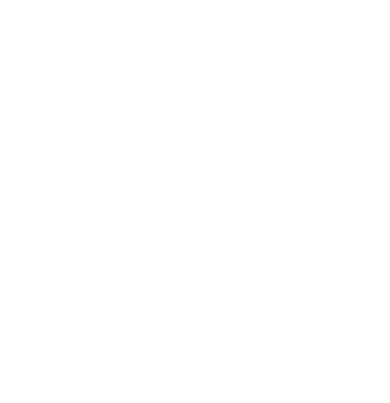
WORLD WIDE WEB NOTE
For practice on problems involving distance and the Pythagorean Theorem, visit the companion website and try THE GEOMETRIZER.
PRACTICE EXERCISES
1. Plato exercises by walking laps around a circular track that is 200 feet in diameter. If he walks 20 laps, approximately how far will he have walked
A. 2.4 miles B. 119 miles C. 5.9 miles D. 11.8 miles
2.

3. Two boats leave the dock at 12:00 noon, one of them moving northward at 6 miles per hour, and the other moving westward at 8 mph. How far apart are the boats after 2 hours?
A. 20 miles B. 28 miles C. 10 miles D. 14 miles
4. The diagram below shows one exterior wall of a house. The wall has a door that measures 3 ft. by 7 feet, and three windows which each measure 4 ft. by 4 ft. What is the perimeter of the door opening?

A. 53 inches B. 65 inches C. 240 inches D. 4.42 inches
5. The diagram below shows Aristotle’s stroll. He starts at his home, proceeds to the cheese shop, then to the toga store, and then returns home. What is the total distance (in feet) of his journey?

6. The figure
below shows the parcel of land on which Homer the rancher confines his hippos.
The parcel will be enclosed by a fence, at a cost of $1.5 per meter. Find the
total cost.
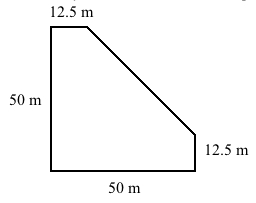
A. $67.60 B.
$214.02 C.
$267.05 D.
$187.50
7. Study the figure below. The distance from the Cheese
Shoppe to Diogenes's home is 1575 feet, and the distance from the Toga Store to
the Cheese Shoppe is 945 feet.
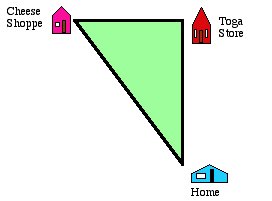
Find the distance from the Toga
Store to Diogenes's home.
A. 1837 feet B. 3780 feet C. 1260 feet D. 630 feet
8. Study the figure below, which illustrates a dilemma facing
the Gainesville City Council. They are going to build a footbridge connecting
City Hall to the Municipal Outhouse, because a number of citizens have perished
while crossing Big Swamp. The distance from City Hall to the Court House is
1440 feet, and the distance from the Court House to the Municipal Outhouse is
1512 feet.
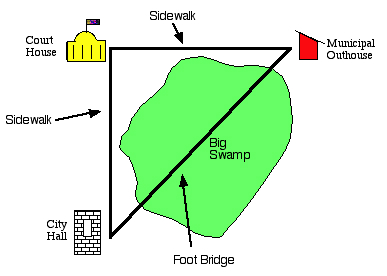
Find the cost of the footbridge,
assuming that such a structure costs $21 per foot.
A. $43848 B.
$54810 C.
$61992 D.
$65772
9. Plato has raised a 91-foot-high flag pole. The flag pole is
supported by 5 wires, each of which is attached to the flag pole at a place
that is 19 feet from the top of the pole and attached to the ground at a place
that is 54 feet from the base of the pole. Find the total length of all 5
wires.

A. 450 feet B. 225 feet C. 338 feet D. 90 feet
10. Study the figure below (which is not drawn to scale).
Euclid has spent the afternoon sunbathing at point X on the south bank of the
river. However, directly across the river at point Y he sees his buddies
drinking beer. He decides to swim across to where they are, but the swift
current carries him downstream so that he arrives at point Z instead.
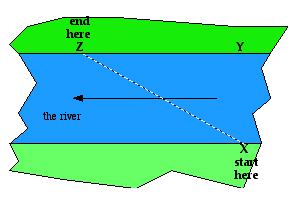
Assuming that the distance from X
to Y is 402 feet and the distance from X to Z is 670 feet, how far from his
intended destination did Euclid end up?
A. 536 feet B.
781 feet C.
668 feet D.
268 feet
11. Find the distance around the racetrack shown below.
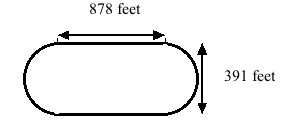
A. 2238.3 feet B.
105423616.9 feet
C. 1492.2 feet D.
2984.4 feet
ANSWERS TO LINKED EXAMPLES
EXAMPLE 2.5.3 C
EXAMPLE 2.5.4 A
EXAMPLE 2.5.5 C
EXAMPLE 2.5.6 A
EXAMPLE 2.5.7 About 66,700 miles per hour
EXAMPLE 2.5.9 5 miles
ANSWERS TO PRACTICE EXERCISES
1. A 2. D 3. A 4. C 5. B 6. C
7. C 8. A 9. A 10. A 11. D